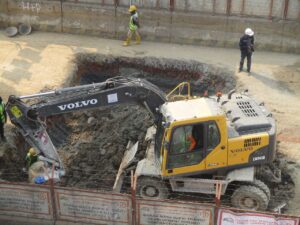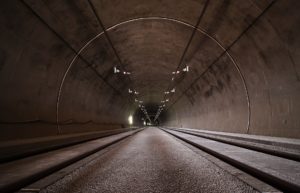The need to find sustainable solutions to the challenges of climate change and increasing urbanization makes metro construction an important platform for innovation and sustainable development. As cities have grown, subway construction methods have also evolved to adopt more environmentally friendly and resource-efficient approaches. In this paper, we will look at sustainable construction methods in modern metro construction that can help improve urban mobility while reducing environmental impacts.
The importance of sustainability in subway construction
Subway construction plays a critical role in addressing urban mobility challenges. There is a growing demand for environmentally friendly and sustainable transportation solutions, and subways meet these needs in many ways. A sustainable metro not only provides an efficient and fast means of transportation, but also reduces road traffic, CO2 emissions, and air pollution in urban areas.
Energy-efficient metro systems
An important aspect of sustainable construction methods in metro building is the energy efficiency of the metro system. By using modern technologies and switching to renewable energy sources, subway operators can reduce subway energy consumption while minimizing the impact on the environment. Below are some measures to improve energy efficiency:
- Energy recovery systems: modern subways can recover the energy generated during braking and reuse it to power the trains. This helps reduce energy consumption and operating costs.
- Lighting and ventilation: LED lighting and energy-efficient ventilation technology are used in subway stations and tunnels to significantly reduce electricity consumption.
- Energy-optimized timetables: Planning timetables taking into account traffic demand and energy efficiency optimizes metro energy consumption and minimizes delays.
- Photovoltaic systems: installing photovoltaic systems on the roofs of metro stations can help generate some of the electricity needed from renewable sources.
Sustainable building materials
The selection of sustainable construction materials is another important aspect of green subway construction. The use of environmentally friendly materials can reduce carbon dioxide emissions, resource consumption, and the environmental impact of subway construction. The following are some examples of sustainable construction materials:
- Recycled materials: using recycled materials (e.g., recycled concrete or recycled steel) in subway construction can reduce waste and the need for natural resources.
- Ecological building materials: using ecological building materials such as wood or bamboo can reduce the environmental impact of subway construction.
- Low- or zero-emission concrete: Using low- or zero-carbon concrete can significantly reduce carbon emissions (CO2 emissions) during construction.
- Green space and greening: incorporating green space and greening into subway stations and tunnels not only improves air quality, but also creates a more pleasant environment for passengers.
Environmentally friendly tunnel construction
Tunneling is an important part of subway construction and can have a significant impact on the environment. Environmentally friendly tunneling construction methods aim to minimize these impacts. Some of the methods used to achieve this goal are presented below:
- Shotcrete and tunneling: The use of shotcrete and tunneling methods reduces surface disturbance and minimizes the impact on the surrounding ecosystem.
- Drilling fluids and recovery: When tunnel boring machines are used, drilling fluids can be recovered and recycled to minimize impacts on groundwater and the aquatic environment.
- Soil improvement: in areas with sensitive soils, soil improvement helps to increase soil stability during tunnel construction and prevent potential soil erosion.
Climate–friendly metro stations
Metro stations are important interfaces for urban transportation and provide opportunities to implement sustainable initiatives. Climate–friendly metro stations can have a variety of functions and features that contribute to sustainable development:
- Rainwater and wastewater management: Rainwater management systems can be used to collect and store rainwater, which can then be used to irrigate lawns or flush toilets.
- Solar energy: Photovoltaic systems installed on Metro roofs can help generate renewable energy and reduce energy consumption at stations.
- Heat recovery: heat recovery systems can use waste heat from electrical equipment and trains to reduce heating costs in stations.
- Green spaces and vertical gardens: integrating green spaces and vertical gardens into subway stations can improve air quality and create a pleasant environment for passengers.
Integrating bicycle and pedestrian transportation
A sustainable subway needs to be integrated into the overall urban transportation system to ensure efficient and environmentally friendly mobility. Integrating bicycle and pedestrian transportation into subway stations allows for a seamless transition between modes and promotes environmentally friendly mobility in the city. Bicycle parking, bicycle rental stations, and safe sidewalks are important elements in promoting sustainable use of the subway.
Civic engagement and social sustainability
A sustainable metro should not only be environmentally friendly, but also promote social sustainability. Citizen participation and the involvement of local communities in the planning and construction process are crucial to ensure that the metro meets people’s needs and improves their quality of life. Creating accessible metro stations and accommodating people with disabilities are also important aspects of social sustainability.
Challenges and outlook
While sustainable construction methods in metro construction offer promising solutions, they also face challenges. Financial and political challenges can hinder the implementation of sustainable initiatives in subway construction. In addition, sustainable construction methods often require careful planning, research, and collaboration among various stakeholders.
However, the outlook for sustainable subway construction is optimistic. As awareness of environmental issues and sustainability grows, cities around the world will increasingly seek environmentally friendly transportation solutions. Advances in technology and research will continue to open up new opportunities for sustainable construction methods in metro building.
Summary
Sustainable construction methods in modern metro construction are an important step towards environmentally friendly and efficient transportation in urban areas. Energy-efficient metro systems, sustainable building materials, green tunneling, and climate-friendly metro stations are some of the ways in which metro construction can contribute to a more sustainable future. By taking a holistic view and integrating environmentally friendly and socially sustainable approaches, metros can be a key component of sustainable urban development.



